HOME > Program Members > Kazuo Tsubota

Kazuo Tsubota

Professor, Department of Ophthalmology, Graduate School of Medicine, Keio University
Kazuo Tsubota, MD, PhD
tsubota@sc.itc.keio.ac.jp
http://www.tsubota.ne.jp
Theme
Practical implementation of feasible regenreative medicine
-Regeneration of the cornea-
All the the 3 layers of the cornea, namely, the epithelium, stroma and endothelium, need to be transparent for useful vision. Patients with epithelial stem cell dysfunction cannot be treated by conventional transplantation, and require stem cell therapy. In addition, in order to address the global shortage of donor tissues, were are currently involved in a study of corneal regeneration using tissue stem cells and induced pluripotent stem cells (iPS). In order to anatomically and functionally restore the cornea, our current studies involve the following: 1) Isolation of stem cells from the 3 layers of the cornea. 2) Induction of corneal cells from iPS cells. 3) Devising of tissue engineering techniques to produce 3-dimensional corneal tissue constructs. 4) Development of new surgical techniques. 5) Establishing the infrastructure required for the processing of safe tissue-engineered products.
Research activities
Isolation of mouse corneal epithelial stem cells
We devised a protocol using cholera toxin and serum-free medium to isolate corneal epithelial progenitor cells from a single mouse cornea (Ma X, Invest Ophthalmol Vis Sci 2009). One of the original cell lines has maintained a normal phenotype and karyotype through over 60 passages (Kawakita T. J Cell Mol Med. 2008).
Isolation of corneal stromal stem cells
We successfully isolated multipotent, neural crest-derived stem cells (COPs) from the adult murine cornea using the neurosphere technique (Yoshida S. Stem Cells 2006).
GMP grade cultivated epithelial sheets
We established a technique for engineering safe, transplantable epithelial sheets using donor human mesenchymal stem cells as feeder cells. The sheets are engineered in a cell processing center under strict sanitation standards. The initial clinical trial was approved by the Ministry of Health, Labour and Welfare.

Fig.1 (Left) Transplantable epithelial sheets using corneal epithelial stem cells and mesenchymal stem cell-derived feeder cells. (Right) Current projects include the differentiation of corneal stroma and endothelium from neural crest stem cells.

Fig.2 Isolation of stem cells (cornea-derived progenitor cells: COPs) from the adult mouse corneal stroma using sphere cultures. COPs express the stem cell marker, Musashi 1, as well as neural-specific nestin.
Selected Paper
- Tsubota K, Satake Y, Kaido M, Shinozaki N, Shimmura S, Bissen-Miyajima H, Shimazaki J. Treatment of severe ocular surface disorders with corneal epithelium stem-cell transplantation. N Engl J Med. 340: 1697-1703, 1999.
- Yoshida S, Shimmura S, Matsuzaki Y, Okano H, Tsubota K. Isolation of multipotent neural crest-derived stem cells from the adult mouse cornea. Stem Cells. 24: 2714-2722, 2006.
- Higa K, Shimmura S, Kato N, Kawakita T, Miyashita H, Itabashi Y, Fukuda K, Shimazaki J, Tsubota K. Proliferation and differentiation of transplantable epithelial sheets engineered with or without an amniotic membrane carrier. Invest Ophthalmol Vis Sci. 48: 597-604, 2007.
- Miyashita H, Shimmura S, Higa K, Yoshida S, Kawakita T, Shimazaki J, Tsubota K. A novel NIH/3T3 duplex feeder system to engineer corneal epithelial sheets with enhanced cytokeratin 15-positive progenitor populations. Tissue Eng. 14:1275-1282, 2008.
- Omoto M, Miyashita H , Shimmura S,Higa K, Kawakita T, Yoshida S, McGrogan M, Shimazaki J, Tsubota K. The use of human mesenchymal stem cell-derived feeder cells for the cultivation of transplantable epithelial sheets. Invest Ophthalmol Vis Sci. in press
Copyright © Keio University. All rights reserved.
